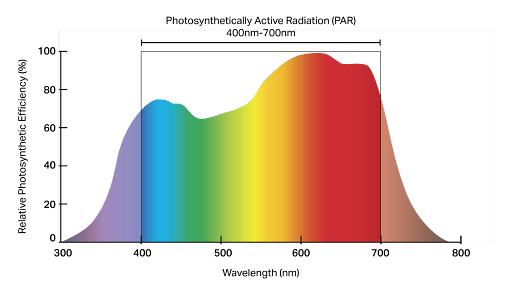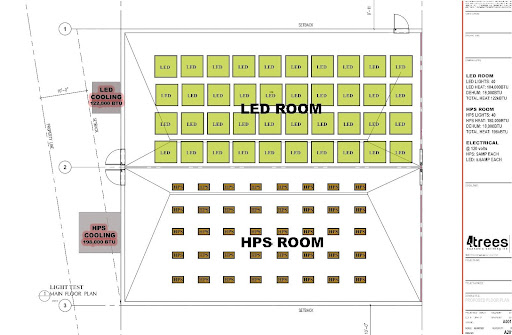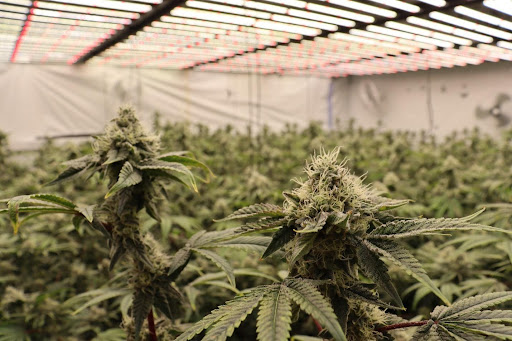The haters will say its fake, and old-school growers will swear by high pressure sodium lighting because it’s worked fine for decades, but the truth is LED grow lighting is undeniably making big waves in the cannabis industry, and with good reason.
High pressure sodium or (HPS) lighting has earned the heavyweight title that it has is because of its high micromole value over time, but there are many good commercial LED lights entering the ring lately that are exceeding what HPS lighting has been offering with spectrums that can be closer tuned, less heat produced and offering a lower power draw.
When choosing the right grow light of any variety there are some basic principals that we need to focus on to select the right light.

SELECTING THE RIGHT LIGHT
A grow light needs to offer the right spectrum that we want for our cannabis plants throughout various stages of the plant’s life, intense light penetration, low heat generation and good power consumption. That’s not too much to ask, is it?
CLONE & SEED LIGHTS
For very early on in the plant’s life such as seedlings, or clones it is best to use either fluorescent lighting or low powered LED lighting. The intensity is not important in this stage but lighting with a full spectrum leaning towards more blue light to promote shorter internode spacing is ideal.
Ideal intensity range: 350 μmol/s – 550 μmol/s
VEGETATIVE LIGHTING
Plants that are further established and in the vegetative phase will require more intense light then clones and seeds but not as much as flowering plants. Ideally you keep a full spectrum in this room and use half as much as a flowering room.
Ideal intensity range: 1,000 μmol/s – 1,300 μmol/s
FLOWERING LIGHTING
The flowering rooms are where lights intensity and spectrum will become very crucial to your success. Many people will choose a cheap LED light to test them out and not have great success at this stage. This is because we want very intense light (1,700 – 2,300 μmol/s) at this stage to properly penetrate our canopies which are generally 3’ or more, full of buds and leaves.
Generally, most LED lights that can outperform an HPS light in this department are over 1,000 (CAD) each, making “test lights” harder for many growers and leaving many people stuck in the HPS days.
Good flowering lighting in either LED or HPS has much more reds to promote larger flower growth. The red-light spectrum will promote larger leaf growth and further internode spacing as well, so it is carefully mixed with a full spectrum still to provide the right mixture. Blue light will help keep our plant’s structure tight so that your flowers form together better and during the flowering phase it is still required to help tighten the buds.
Ideal intensity range: 1,700 μmol/s – 2,300 μmol/s

These ideal intensity ranges are subject to the lights distance from the plants and plant variables such as stress or insects. This is in ideal conditions for healthy plants that’s lights are placed at the right distance from the canopy. Light intensity should be lowered by half for plants undergoing stress of any kind.
Dehumidifiers for these rooms added 18,000 BTU of heat per room.
THE COMPARISON
For this comparison we will be comparing 1,000 watt double ended HPS grow lights and a 850 watt commercial LED grow lights. The commercial LED grow light is exactly similar in μmol value as an average 1,000 watt double ended grow light (2,100 μmol/s).
This is the minimum light intensity we would want to achieve to be able to penetrate the average canopy thickness properly so that all your flowers can get dense. The light distance from the canopy will vary with each type of light though, double ended lights need to be kept much further away from the canopy then LED lights, but LED have no light spread like HPS does.
HEAT GENERATED
High Pressure Sodium lights produce a lot of heat, nearly double what an average high powered commercial LED light will produce. This is something to think about when building your grow room as you will immediately need to calculate the heat load and apply the right amount of HVAC needs. HPS lights may be cheaper, but air conditioning is costly and purchasing bigger cooling units can add up immediately as well as in future energy costs.
Average Heat From a 1000w HPS: 4,000 BTU
Average Heat From a 850w LED: 2,600 BTU
ENERGY CONSUMPTION
LED grow lights are considerably more energy efficient and eco-friendly than HPS grow lighting, which is why many places are offering rebates for switching your grow room to LED. The 100,000-hour run time on the LED lights mean much less disposing of old lights that is necessary with HPS lights every second harvest. The energy savings are equivalent to the HVAC reduction as well, with nearly half the power draw of its counterpart. When the grow lighting energy costs is one of the biggest ongoing expenses with growing, this is something to consider.
Large scale growers such as micro cultivation facilities and licensed producers should pay extra attention to this as grow lighting energy costs are one of the largest on-going costs with a cannabis facility.
Average Energy Draw of a 1000w HPS at 120 volts: 9 AMPS
Average Energy Draw of a 850w LED at 120 volts: 5 AMPS
SPREAD
The light spread of the high-pressure sodium lights are excellent. They can cover a large area and be spaced further apart because of this; however, this is not always ideal. You get hot spots and cool spots where light is intense, and then drops off dramatically. It is much harder to achieve even coverage this way opposed to the light bars that LED lights offer. LED lights offer little to no spread and because of this grower are forced to place them very close together. Lining the ceiling in LED lights like this with evenly placed LED light bars allows you to have extremely even light coverage with little hot and cool spots.

NEW HEAVYWEIGHT CHAMPION?
If you are a small-scale grower, or on a budget then HPS is a fine choice. However, if you operate larger scale operations like a micro cultivation facility or licensed producer its crucial to your success to select the right lighting.
With the spectrum options from HPS lights coming from a mixture of gases, versus LED lights causing the spectrum to change the argument of which one can offer a better spectrum is put to an end right there.
We know they operate at a cooler temperature, offer better light distribution, and cost less to operate. With the only downside being their higher initial price point, when compared to the savings immediately in HVAC costs and future energy consumption costs, LED is the clear heavyweight champion!
